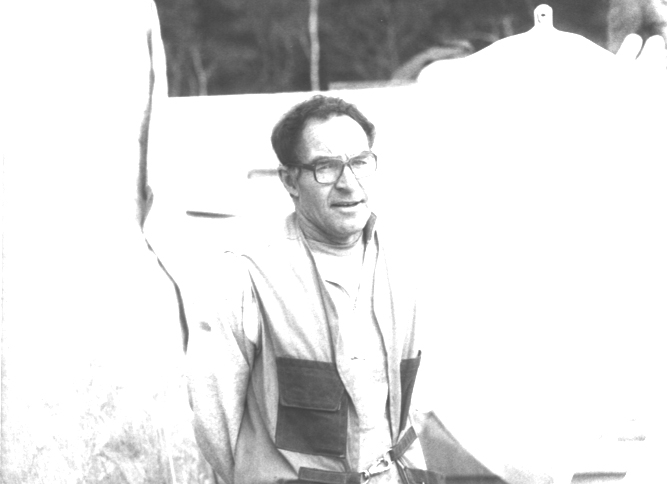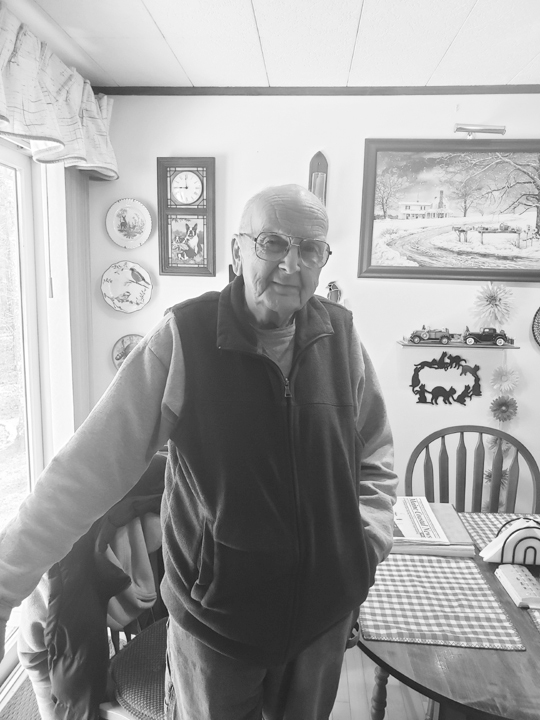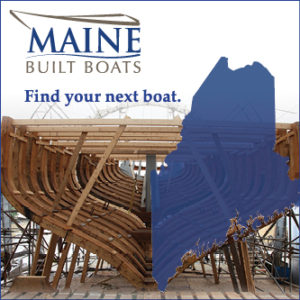
Walter Greene
YARMOUTH – Boatbuilding on the Maine coast is usually associated with traditional boats, power or sail, built with either wood or fiberglass. However, there are those that choose to use high-tech methods when building their boats. One such person is Walter Greene of Yarmouth, who over the years as a designer and builder, especially of multihulls, has become renowned for his creations world-wide and this has earned him a place in the Maine Boatbuilder’s Hall of Fame.
Greene grew up in Guilford, Connecticut, on Long Island Sound. He said, ‘It was a pretty good place to sail. We had a boat called the Zip, which was kind of a neat old keelboat that was about 16 or 17 feet long.’
Before entering high school Greene built himself a Blue Jay. After high school he attended the University of Vermont. After graduation he called on Allan Vaitses, a well-known boatbuilder from Mattapoisett, Massachusetts, looking for a job. Vaitses said that he asked him what he could do and he said, ‘nothing.’ He then asked what him what he was willing to do and he said ‘anything.’ With that answer Vaitses told him to come on up.
During the early 1970s Greene worked with Vaitses learning all aspects of boatbuilding. During his time there they built all sorts of boats out of fiberglass.
Greene said, ‘Actually the most interesting project was Cascade, the IOR cat-ketch. Another interesting boat for me was Gulf Stream, the first boat for Phil Weld. However, I left in the middle of that because Vaitses had sold the business.
‘I was there until ’73,’ continued Greene. ‘My wife got a job working with Harvard medical school and we moved to Marblehead and I went to work for the Hoods. Was mostly sailing on Robin and when I wasn’t doing that I was working in the boat yard.’
Ted Hood built two or three boats a year and Greene stayed on for about three years. Greene had started sailing in multihulls with Phil Weld in 1972 and built Friends, a Newick design, at Hood’s yard in 1976. That same year he entered her in the single-handed transatlantic race and placed eighth.
That same year he left Hoods and went to work for Merle Hallett at Handy Boat in Falmouth, Maine. They built a two tonner right off and then Moxie, a Freedom 33 prototype and a 56-trimaran. Greene added, ‘We never did two the same or anything very racy except for Moxie. We did build a boat called Goulois IV (named for a French cigarette company) that I designed. It led the OSTAR and was a head of Phil Weld when it broke the wing deck in a storm.’
When Mike Birch won the single-handed transatlantic race with a Greene designed racer in 1978, Greene sold some designs in Europe.
In 1980 he left Handy Boat and opened his own shop next to Even Keel Boat Shop in Yarmouth, down behind the Muddy Rudder. They built two 53 footers that winter. They started them in October and launched them in April. Greene added, ‘Both those broke because we had trouble with the klegecell in the hulls. The one I was sailing on broke 600 miles from Nova Scotia and we limped in there. The other boat won its class, but it was broken at the finish. We spent about six months rebuilding those boats.’
Following this there was a dry spell. They built a couple of 35-footers and a few monohulls. In 1983/4 they built the 45-foot Sebago, which was later extended to 50 feet. Greene explained, ‘She was somewhat under powered for upwind racing and maybe it didn’t carry its displacement well enough. The best thing we ever did was win our class in the Round Britain Race. The boat is still sailing today in the Keys as a day charter boat. It has gotten a lot more use that way than it ever did as a racing boat.’
In 1994, Greene built a 57-foot day charter multihull for a customer from Newport, Rhode Island, who worked her out of Newport that summer.
Over the years Greene continued building and repairing at his yard.
In 1998 they built a floating Docksider deck shoe for Sebago, Inc. This was not an easy feat when one considers all the details, like the laces. That same year Greene Marine built a wave piercing cat, powered with twin 115-hp Johnson outboards, for Jeff Anderson of New Hampshire.
In 2001 he built a 43-foot powered passenger-carrying catamaran for a customer from South Carolina, which he designed.
Greene Marine’s next big project will be building another trimaran like Scout, which the built two years ago for a local customer. They will begin this project this coming winter.
During the winter of 2002 the were refurbishing a five-year-old 22-foot Mini-Transit race boat, and building a 31-foot Dick Newick designed trimaran. That same year they began construction of a 38-foot trimaran designed by Greene for a customer from Deer Isle. One very interesting aspect of this boat is her A-frame rig, which is held up with a fore and backstay.
This winter Greene Marine is refurbishing the first Formula 40, a major project and they are going over Great American II, before she competes in the singlehanded trans-Atlantic race.
As for a high-tech builder, Greene said, ‘May be for Maine, but not the nation. Goetz builds more high tech stuff and uses more carbon then we do. We know how to use it all and would like to but it is not that big a market.’
Whether he will admit it or not, Walter Greene is one of the premier boatbuilders on the coast of Maine, especially in the use of high tech materials. He is also one of the most practical builders, knowing exactly what it takes to do the job for the least amount of time and money. He is a wealth of knowledge, which he loves to pass on to anyone interested. So, when you are looking to build, especially a multihull, make sure you consult with Walter Greene, the newest member of the Maine’s Boatbuilder’s Hall of Fame.”
Robert Rice
1938-2024
Robert B. Rice, 85, passed away on 2 August at St. Andrews Village in Boothbay Harbor.
He was born at home on 17 November 1938, the son of Baxter M. and Rheta M. (Bridges) Rice on Murray Hill Road in East Boothbay.
Robert attended local schools and was employed at his grandfather’s shipyard, Rice Brothers Corporation for a year. In 1946, Rice Brothers Corporation was Henry, Robert’s father Baxter, and his brothers, Carl and Donald. Robert was the last employee of Rice Brothers. He worked there during the summers while in high school. He said the work was pretty easy, all he had to know was how to operate a broom. He then went to work there full-time as a boiler and crane operator in 1955. When his cousin came back from the service Robert worked with Paul Luke’s father doing carpentry work building 40-foot personal boats for the U. S. Navy. Robert said, “I got up one day and went to work and while I was working, I stopped and I looked around at that stupid yard and I said, that is it. I am gone.”
Robert loved history and had done a lot of reading and wanted to see the places he had read about so he joined the U. S. Army after quitting his job at Rice Brothers. He did his basic training at Fort Dix, New Jersey and then it was off to Fort Belvoir, Virginia for advanced training. For most of his career he worked in procuring, with an exception of a tour in Vietnam. Robert came home from France after three years in 1959 on leave. The second day he got out his little notebook, ran down the list of names. They were either gone, married, or weren’t home until the last name in the book, which was June E. Rowe. She was home and answered the phone. They were married in 1960 and she would accompany him on all the tours of duty except Vietnam. Together they traveled and saw a lot of Europe, but they were always happy to come home for leave. Robert was a member of the American Legion Post 36 in Boothbay. He was awarded with the following decorations; Meritorious Service Medal 1st 2nd awards, Meritorious Unit Citation (Combat), five Good Conduct Medals, National Defense Medal, Vietnam Service Medal, Vietnam Cross of Gallantry with Palm, and Combat Infantry Barge.
When Robert retired from the Army in 1976 he came right back to East Boothbay and went to work as a maintenance foreman for Smuggler’s Cove Motel. He worked there six years and rebuilt a great deal of the Motel. Then he hooked up with a person he knew at Ocean Point who wanted him to help build a house together during the winter. Later, Robert began working for himself repairing or building new houses in East Boothbay. Over the years he had a number of people work alongside of him. He also had both of his grandsons work a number of years before going off on their own. The road Robert lived on he built all but one of the houses on it. He fully retired seven years ago and added that he did not miss the work, but he did miss the people. He had said he enjoyed doing it and if he had to do it over again, he would leave out Rice Brothers. Robert was also civil minded, being vice chair of the East Boothbay Water Co. in the 1990s, served as vice president/president, trustee and photo ID and cataloger for 45 years at the Boothbay Region Historical Society, and served as vice president/president of the Tallwood Estates in the 1990s.
If you visit Robert there is one thing that become obvious immediately, his love of making models. He started building them when he was very young, getting assistance from his father on how to do it. Their first boat was a 36-inch PT, one of the fondest memories he had was building it with his father. He never stopped building models and in the end he had done hundreds. He would do boats, planes or vehicles, what ever interested him. He not only built from kits, but did many scratch built models that were very well-done. Some of these you can see at the Boothbay Region Historical Society.
When Robert would come home from work he would go into his model room and close the door. The crazy world was locked out and he really enjoyed his time making models.
When Robert was on duty one night at Fort Knox, Kentucky one of the soldiers came in with a book on warships, “Jane’s Fighting Ships.” Robert asked about it and found a reference to the Rice yard with a little write up and a photograph. At that point he began building a history of the Rice yard. He traveled all over to find information, read all the issues of the Boothbay Register and talked to as many people as he could find with information on Rice Brothers. He developed a very comprehensive history of Rice Brothers, which you can access at the Boothbay Region Historical Society.
Robert is survived by his wife June of East Boothbay; daughter Catherine A. Jurgelevich and her husband Kirk of Gray, Maine, and two beautiful grandsons, Kirk Robert and his wife Samantha Frank, and Ryan William Jurgelevich and his wife Whitney; and great-granddaughter Cora June Jurgelevich all of Windham, Maine and nephew Arthur Carter.
Robert’s family will honor his life privately.

Robert Rice



